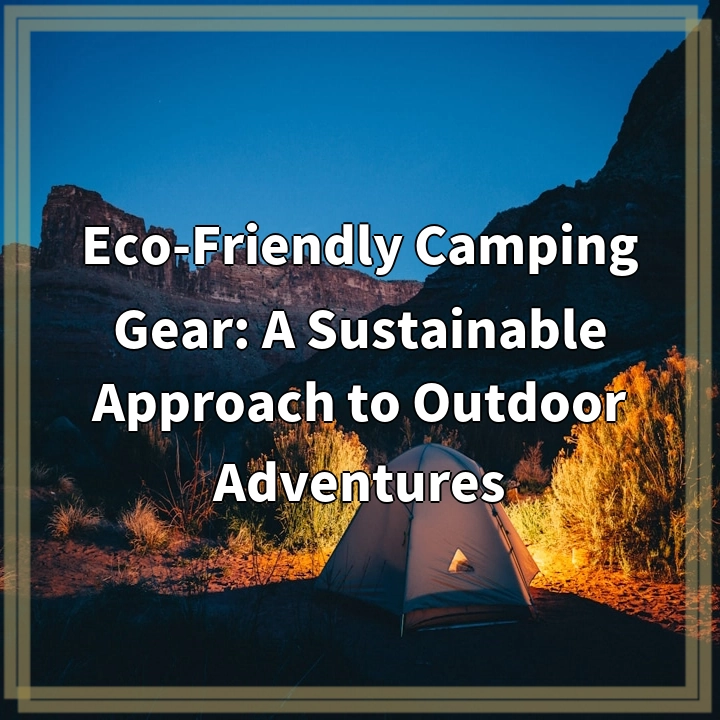
What is Eco-Friendly Camping Gear?
Eco-Friendly camping gear refers to outdoor equipment and accessories that are designed and produced with environmentally-friendly materials and practices. These gear options are conscious of their impact on the environment throughout their lifecycle, from sourcing raw materials to manufacturing, use, and disposal.
Real-World Problems Associated with Traditional Camping Gear
While camping is a great way to connect with nature, traditional camping gear often contributes to environmental degradation and resource depletion. Here are some of the real-world problems associated with conventional camping gear:
1. Non-Biodegradable Materials
Many traditional camping gear products are made from non-biodegradable materials, such as plastics and synthetic fibers. When these items end up in the natural environment, they can take hundreds of years to break down, leading to significant pollution and harm to wildlife.
2. Energy-Intensive Manufacturing
The production of conventional camping gear involves energy-intensive manufacturing processes, which contribute to greenhouse gas emissions and climate change. The extraction and refinement of raw materials, along with the energy used in manufacturing, release significant amounts of carbon dioxide and other harmful pollutants.
3. Chemical Treatments
Some traditional camping gear is treated with chemicals to enhance its performance, such as flame retardants and waterproof coatings. These chemicals can leach into the environment, contaminating soil and water sources and posing risks to both wildlife and human health.
4. Single-Use Culture
Disposable camping gear, such as single-use camping cookware and packaging materials, contribute to a culture of waste and overconsumption. These items often end up in landfills, where they take up valuable space and create long-lasting environmental problems.
5. Lack of Durability
Many traditional camping gear items are not designed for longevity and quickly become worn out or obsolete. This leads to frequent replacements, generating more waste and requiring additional resources to be used in the manufacturing process.
The Need for Eco-Friendly Camping Gear
Given the environmental problems associated with traditional camping gear, there is a growing need for eco-friendly alternatives. The development and use of sustainable camping gear can help mitigate these environmental impacts and enable outdoor enthusiasts to enjoy nature without compromising its integrity.
By choosing eco-friendly camping gear, we can:
- Reduce waste and limit the amount of non-biodegradable materials entering the environment.
- Minimize carbon emissions by supporting brands that prioritize sustainable sourcing and manufacturing processes.
- Avoid exposure to harmful chemicals by opting for gear made with natural and non-toxic materials.
- Promote a circular economy by supporting durable and repairable gear that can be used for years.

Solutions for Eco-Friendly Camping Gear
To address the real-world problems associated with traditional camping gear, here are some solutions:
1. Sustainable Materials
Eco-friendly camping gear is made from sustainable materials such as organic cotton, bamboo, recycled plastics, and hemp. These materials minimize environmental impact and reduce the use of non-renewable resources.
2. Responsible Manufacturing Processes
Brands that prioritize sustainability ensure their manufacturing processes are energy-efficient, minimize waste, and promote fair labor practices. This helps reduce carbon emissions and environmental pollution.
3. Chemical-Free Alternatives
Eco-friendly camping gear avoids the use of harmful chemicals by opting for natural treatments and coatings. This ensures that the gear is safe for both the environment and human health.
4. Reusable and Durable Design
Eco-friendly camping gear is designed to be reusable and durable. By opting for gear that lasts longer, we can reduce the amount of waste generated and minimize the need for frequent replacements.
5. Minimal Packaging
Sustainable camping gear brands often prioritize minimal packaging, reducing the use of single-use plastics and unnecessary waste. This helps minimize the environmental footprint of the products.
Benefits of Eco-Friendly Camping Gear
By embracing eco-friendly camping gear, we can:
- Contribute to a cleaner and healthier environment by reducing waste and pollution.
- Support sustainable practices that help mitigate climate change and protect natural resources.
- Enjoy the beauty of nature without compromising its integrity and the well-being of wildlife.
- Save money in the long run by investing in high-quality gear that lasts for years.
By making conscious choices in the camping gear we purchase, we can ensure a more sustainable approach to outdoor adventures while minimizing our impact on the environment.















